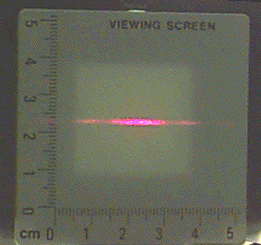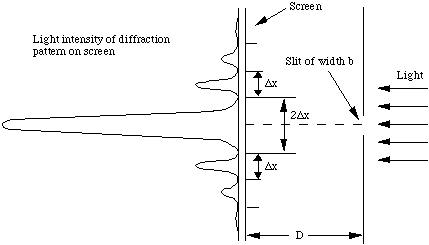Diffraction by a Single Slit

If we illuminate a slit with light of wavelength $\lambda$
comparable to the width of the slit b, a diffraction pattern will be
produced. This pattern is comprised of a bright central band bounded
by dark and bright bands of diminishing intensity as shown in the
picture on the right. If d is much bigger than the wave length of the
light, then the pattern on the screen is just the slit its self. As d
is decreased, the screen shows a diffraction pattern. The central
band widens and the minima and secondary maxima move out. The angles
of the diffraction minima are given by
\[ \rm \mathbf{ \theta_{n} = \frac{n \lambda}{b}; n = 1, 2, 3, ...} \]
If we project the diffraction pattern on a screen a distance D
away, the separation xm between the nth minimum
and the center of the pattern is given by
\[ \rm \mathbf{x_{n} = \frac{n D \lambda}{b}; n = 1, 2,
3, ...} \]
and the distance to the first minimum from the center is
\[ \rm \mathbf{ \Delta x = \frac{D \lambda}{b}} \]

The width of the central maximum is given by 2Dx.
©
MultiMedia
Physics
2000


